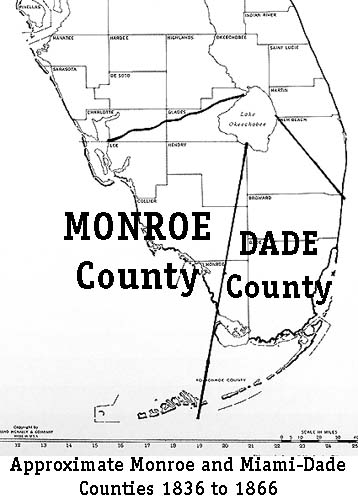GENERAL HISTORY OF INDIAN KEY
Richard Fitzpatrick
and Indian Key, Monroe and Dade Counties
These pages by Jerry WilkinsonMr. Fitzpatrick was among the first civilians to arrive in Key West in 1822 being of the Charleston 'planter' ideology. He just disappeared from Soutn Carolina around 1816 and surfaced in Key West. He was immediately successful, was the only authorized wrecking auctioneer, owned a wrecking ship, and was involved in local and Territorial politics.
For a detailed expose see Richard Fitzpatrick's South Florida 1822-1840 by Hugo Black published in the Tequesta, Volume 40, 1980.
In the 1830s, from the aforementioned Spanish Land Grant owners Fitzpatrick purchased four square miles, two on each side of the Miami River; one square mile on New River (Fort Lauderdale) and a few other smaller holdings. He constructed buildings, brought in slaves and concentrated on every thing from sugar cane to livestock.
Monroe County is Divided
Richard Fitzpatrick an illustrious character like Housman had holdings around Miami which were mortgaged to Mrs. Harriet English of Columbia, S.C., his sister who was also the mother of State Senator Wm. F. English.
Monroe County had three voting precincts; New River (Fort Lauderdale), Indian Key and Key West. In 1836 Fitzpatrick was elected for the second time as the Monroe County Representative to the Florida Legislative Council.
Meanwhile, back on nine-acre Indian Key, Housman and 56 others had petitioned Florida for a separate county.
When the Legislative Council met Jan. 4, 1836, there was not a quorum present and the body adjourned until the next day. Tuesday, Jan. 5, 1836, the council met and Richard Fitzpatrick, member elect from Monroe County, having appeared formed a quorum.
On a motion of Mr. Blount, Mr. Richard Fitzpatrick was nominated and duly elected as President of the Legislative Council.
The appearance of Mr. Fitzpatrick has more than casual interest for us, because among the agenda of the session was a plan for the creation of a new county to be formed from a part of the territory of Monroe County. The new county was established and named Dade, with no vote of opposition.
From these facts we may assume that the plan was attributable to Richard Fitzpatrick and at least partly to Housman, because we know enough of senatorial courtesy and of human nature to be convinced that the dismemberment of Monroe would not have been permitted without the approval of her representative. We may, therefore, with good reason, acclaim Richard Fitzpatrick as the Father of Dade County.
The name of the new county must have come spontaneously to every tongue. On Dec. 28, 1835, only seven days before the session convened, the catastrophe known as the Dade Massacre occurred in central Florida. Appropriately the Legislative Council, in creating the new county made it a memorial to Major Dade. The act was approved by the Governor Jan. 28, 1836.
The portion of Monroe County assigned to the new county of Dade was that part lying north of a direct line running from the west end of Bahia Honda Key to Cape Sable and east of a line running directly from Cape Sable to Lake Macaco, now Lake Ocheechobee. The county seat was located at Indian Key.
Needless to say, Key West was dismayed. They had just lost one half the county and most of the stepping stones (the Middle and Upper Keys) to the mainland.
On February 4, 1836, the eastern part of former Monroe County east of Bahia Honda and north to Lake Okeechobee officially became Dade County with Indian Key as its county seat.
Fitzpatrick became Dade County's representative from 1837 to 1841. After the Indian War ended in 1842, Fitzpatrick was financially hurting and sold his mainland holdings to his nephew, William English, formerly of Indian Key. Fitzpatrick moved to Texas and later he and English both went to the California Gold Rush.Indian Attacks Coontie was an arrowroot starch made from the Zamia integrifolia. Some argue that coontie was Monroe County's first industry as many on the mainland delved into its production. One of the better known producers of coontie was William Cooley. He arrived on New River in 1824 and built a large 'coontie' mill on the Lewis property (later rented from Fitzpatrick). Cooley was also a wrecker and while away on a wrecking trip the Seminoles attacked his home on January 6, 1836. (See web page 2 of the Seminoles) His wife, baby, son and daughter were killed and his slaves taken.Cape Florida Lighthouse The 1790 Fornells' land grant was sold to Mary Ann and William Davis. They sold three acres for the construction of the Cape Florida Lighthouse. John Dubose lit the lamps on December 17, 1825. The hurricane of 1835 failed to extinguish the light, but on January 6, 1836 the Seminoles were more successful. They waited until nightfall and set fire to the wooden door. Assistant-keeper, John Thompson and his helper, Aaron Carter, attempted to fight them off to no avail. Thompson survived, but Carter was killed. The lighthouse was disabled until 1846.
Note that both Cooley and lighthouse attacks occurred in early 1836. On Indian Key, Jacob Housman formed Company B, 10th Florida Militia in January 1836 with himself as the captain. The next month all this area became Dade County via legislature passed by Fitzpatrick. Indian Key, as a Dade County community, thrived until the 1840 massacre. On August 7, 1840, a group of the few remaining Seminoles attacked and burned all but one house.The Former Indian Key Players After the Indian Key massacre Jacob Housman returned to Key West in 1840 where he died the following year. Charles Howe returned to Key West in 1842 where he became the Collector of Customs, controlling interest in the LaFayette Salt Co. and a city leader. Richard Fitzpatrick sold his Dade County holdings to his nephew, William English, formerly of Indian Key. Fitzpatrick moved to Texas and later, he and English both went to the California Gold Rush. Monroe County regained its present boundary ownership in 1866. The eastern part of Monroe County remained as it is today, but the western boundary continued to extend northward to Fort Myers. Fort Myers became a formidable port itself and led in the formation of Lee County in 1887. Story has it that Monroe County would not rebuild its school house that had burned and they formed Lee County; therefore, Monroe County was reduced to its present-day boundaries. Lee Country was later divided into presentday Collier, Hendry and Lee Counties. The 1870 census revealed 46 residents residing on Indian Key, of which three were Pinder families, who moved and homesteaded the center part of Upper Matecumbe Key.Continue TOUR to history of the Seminole Indians.
OR
Return to Indian Key Homepage
